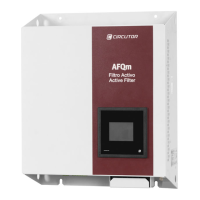37
Instruction Manual
AFQm
3.8.2.- CONNECTING CABINETS
Note: The 200A (AFQm-xxx-200C), 300A (AFQm-xxx-300C) and 400A (AFQm-xxx-400C) cabinets
are made up of 2, 3 and 4 100A devices in parallel. Both the parallel configuration and connection are
factory-set.
The 140A (AFQm-xxx-140C), 210A (AFQm-xxx-210C) and 280A (AFQm-xxx-280C) cabinets are made
up of 2, 3 and 4 70A devices in parallel.
Note: Both the parallel configuration and connection are factory-set.
To connect multiple cabinets in parallel, follow these steps:
1.- Select the cabinet that is to contain the “master” device.
2.- Connect the “master” cabinet. The current transformers are only connected to the “master” cabinet.
3.- Connect the “slave” cabinets.
4.- Connect all of the devices using the communication cables (Table 16).
Connect the OUT terminal from the final slave device in the “master” cabinet to the IN terminal from
the “master” device of the following cabinet, and the OUT terminal from the final “slave” device in this
cabinet to the IN terminal of the “master” device of the following cabinet, and so on (Figure 31).
Master Slave Slave
(*)
Connections already included in the cabinets
IN
OUT
2
3
2
3
IN
OUT
2
3
2
3
OUT
IN
2
3
IN
2
3
OUT
2
3
2
3
AFQm-xxx-200C
(*)
(*)
OUT
IN
2
3
IN
2
3
OUT
2
3
2
3
(*)
ON
RBUS
ON
RBUS
ON
RBUS
ON
RBUS
ON
RBUS
ON
RBUS
Figure 31:Connecting 3 devices in parallel, using the communication cable (200 A Master AFQm).
5.- Configure the installation in the “master” device (see “7. CONFIGURATION”.
6.- Complete the configuration of the slave devices (see “7.- CONFIGURATION”).
7.- Enable the terminator switch for parallel connection, RBUS (Terminal No 2 of Table 13) in the bus
end devices only. Then disable in the other devices.

